Amish and Mennonites are two distinct religious groups that originated from the Anabaptist movement in Europe during the 16th century. While they share some similarities in their beliefs and practices, there are also significant differences between the two. This article aims to provide an introduction to the question of whether Amish and Mennonites are the same.
Table of Contents
History and Origins of the Amish and Mennonites
Are Amish and Mennonites the same? This is a question that often comes up when discussing these two religious groups. While they do share some similarities, they are not exactly the same. To understand the differences between the Amish and Mennonites, it is important to delve into their history and origins.
The Amish and Mennonites both trace their roots back to the Anabaptist movement of the 16th century. This movement emerged during the Protestant Reformation and was characterized by a belief in adult baptism and the separation of church and state. The Anabaptists faced persecution for their beliefs and sought refuge in various parts of Europe.
The Amish, named after their founder Jacob Amman, originated in Switzerland in the late 17th century. Amman believed in strict adherence to the Ordnung, a set of rules and regulations that govern every aspect of Amish life. The Amish migrated to North America in the 18th century, settling primarily in Pennsylvania, Ohio, and Indiana.
On the other hand, the Mennonites were named after Menno Simons, a Dutch Catholic priest who converted to Anabaptism in the 16th century. Simons emphasized pacifism and nonresistance, which became core principles of the Mennonite faith. The Mennonites also faced persecution and migrated to North America, settling in various regions, including Pennsylvania, Kansas, and Ontario.
While both the Amish and Mennonites share a common Anabaptist heritage, they have developed distinct practices and beliefs over time. One of the key differences lies in their approach to technology. The Amish are known for their rejection of modern technology, preferring to live a simple and traditional lifestyle. They shun electricity, automobiles, and other modern conveniences, opting for horse-drawn carriages and manual labor. In contrast, Mennonites have embraced technology to varying degrees, with some communities adopting modern conveniences while others maintain a more conservative approach.
Another difference between the Amish and Mennonites is their approach to dress and appearance. The Amish are known for their distinctive clothing, which reflects their commitment to modesty and simplicity. Men wear plain suits and hats, while women wear long dresses and bonnets. Mennonite dress, on the other hand, varies depending on the community and individual beliefs. Some Mennonites may dress similarly to the Amish, while others may adopt more contemporary styles.
In terms of religious practices, the Amish and Mennonites also have some variations. The Amish worship in private homes or barns, with services conducted in the Pennsylvania German dialect. They emphasize community and the importance of living a righteous and obedient life. Mennonites, on the other hand, have a more diverse range of worship styles, with some congregations meeting in traditional church buildings and others in more informal settings. They place a strong emphasis on peace, social justice, and service to others.
In conclusion, while the Amish and Mennonites share a common Anabaptist heritage, they have distinct histories, practices, and beliefs. The Amish are known for their rejection of modern technology and distinctive dress, while the Mennonites have embraced technology to varying degrees and have a more diverse range of dress and worship styles. Understanding these differences helps to shed light on the unique identities and contributions of these two religious groups.
Key Differences Between Amish and Mennonite Beliefs and Practices

Are Amish and Mennonites the same? This is a question that often comes up when discussing religious groups that have similar beliefs and practices. While there are certainly similarities between the two, there are also key differences that set them apart. In this article, we will explore some of these differences and shed light on the unique aspects of both Amish and Mennonite beliefs and practices.
One of the main differences between Amish and Mennonite beliefs is their approach to technology. The Amish are known for their rejection of modern technology, preferring to live a simple and traditional lifestyle. They believe that technology can lead to worldly temptations and distractions from their faith. On the other hand, Mennonites tend to be more open to technology, although they may still have certain restrictions or guidelines in place. This difference in attitude towards technology is one of the key distinctions between the two groups.
Another difference lies in their approach to dress and appearance. The Amish are known for their distinctive clothing, which is often plain and modest. They believe that dressing simply and modestly is a way to separate themselves from the world and to focus on their faith. Mennonites, on the other hand, may have a more varied approach to dress, with some groups adopting a similar plain and modest style, while others may dress more similarly to the general population. This difference in dress reflects the varying levels of separation from the world that each group embraces.
In terms of worship practices, both Amish and Mennonites place a strong emphasis on community and fellowship. However, there are some differences in how they approach worship. Amish worship services are typically held in homes or barns, with a focus on simplicity and humility. They believe that worship should be a personal and intimate experience. Mennonites, on the other hand, may have more formalized worship services in church buildings, with a greater emphasis on music and singing. This difference in worship style reflects the varying cultural and historical backgrounds of the two groups.
One of the most significant differences between Amish and Mennonite beliefs is their approach to education. The Amish believe in providing education within their own community, often through one-room schoolhouses. They emphasize practical skills and education that will prepare their children for a life within the community. Mennonites, on the other hand, tend to have a more open approach to education, with many Mennonite children attending public or private schools. This difference in education reflects the varying levels of integration with the outside world that each group embraces.
In conclusion, while Amish and Mennonites share some similarities in their beliefs and practices, there are also key differences that set them apart. These differences can be seen in their approach to technology, dress and appearance, worship practices, and education. Understanding these distinctions can help to shed light on the unique aspects of both Amish and Mennonite communities. Whether you are curious about these religious groups or simply interested in learning more about different faith traditions, exploring the differences between Amish and Mennonite beliefs and practices can be a fascinating journey.
Similarities in Lifestyle and Values Between Amish and Mennonite Communities
Are Amish and Mennonites the same? This is a question that often comes up when discussing these two religious groups. While they do share some similarities in lifestyle and values, there are also distinct differences that set them apart. Let’s take a closer look at the similarities between Amish and Mennonite communities.
One of the most striking similarities between the Amish and Mennonites is their commitment to a simple and traditional way of life. Both groups emphasize the importance of living a life that is separate from the modern world. They believe in simplicity, humility, and self-sufficiency. This means that they often reject modern conveniences such as electricity, cars, and televisions. Instead, they rely on traditional methods of transportation, such as horse and buggy, and use manual labor for their daily tasks.
Another similarity between the Amish and Mennonites is their strong emphasis on community and family. Both groups place a high value on close-knit communities and the importance of supporting one another. They believe in the power of working together and helping each other in times of need. This is evident in their practice of barn raising, where the community comes together to build a barn for a family in need. It is also seen in their commitment to education, with both groups placing a strong emphasis on homeschooling and passing down their values and traditions to the next generation.
In addition to their shared values, the Amish and Mennonites also have similar religious beliefs. Both groups are considered Anabaptist, which means they believe in adult baptism and the separation of church and state. They also believe in the importance of pacifism and non-violence, which is why you will rarely find members of these communities serving in the military. Instead, they choose to resolve conflicts peacefully and promote peace in their communities.
While there are many similarities between the Amish and Mennonites, it is important to note that there are also distinct differences that set them apart. One of the main differences is their level of strictness when it comes to adhering to their traditional way of life. The Amish tend to be more conservative and strict in their practices, while the Mennonites are often more liberal and open to modern influences. This can be seen in their dress, with the Amish wearing plain and simple clothing, while the Mennonites may dress more similarly to the general population.
Another difference between the two groups is their approach to technology. While both the Amish and Mennonites reject certain modern conveniences, such as electricity, the Amish tend to be more strict in their rejection of technology. They believe that technology can lead to worldly temptations and distractions, and therefore choose to live without it. On the other hand, Mennonites may be more open to using technology, as long as it does not interfere with their values and way of life.
In conclusion, while the Amish and Mennonites share many similarities in lifestyle and values, they are not the same. Both groups emphasize simplicity, community, and traditional values, but there are distinct differences in their level of strictness and approach to modern influences. Understanding these similarities and differences can help us appreciate the rich diversity within these religious communities.
Contemporary Challenges and Changes within Amish and Mennonite Communities
Are Amish and Mennonites the same? This is a question that often comes up when discussing these two religious groups. While they share some similarities, there are also distinct differences between the Amish and Mennonites. In this article, we will explore these differences and shed light on the contemporary challenges and changes within Amish and Mennonite communities.
To begin with, both the Amish and Mennonites are Christian denominations that originated from the Anabaptist movement in Europe during the 16th century. They both emphasize the importance of living a simple and humble life, and they both reject the idea of infant baptism. However, their beliefs and practices diverge in several key areas.
One of the main differences between the Amish and Mennonites is their approach to technology. The Amish are known for their strict rejection of modern technology, while Mennonites tend to be more open to its use. The Amish believe that technology can lead to worldly temptations and distractions, so they choose to live without electricity, cars, and other modern conveniences. On the other hand, Mennonites may use technology to varying degrees, depending on their specific community and beliefs.
Another difference lies in their approach to dress and appearance. The Amish are known for their distinctive clothing, which is plain and modest. Men typically wear dark-colored suits and hats, while women wear long dresses and cover their heads with bonnets. Mennonites, on the other hand, may dress more similarly to the general population, although they still tend to prioritize modesty in their attire.
In terms of education, the Amish and Mennonites also have different approaches. The Amish typically prioritize education within their own community and often have their own schools, which focus on practical skills and religious teachings. Mennonites, on the other hand, may choose to send their children to public or private schools, although they still emphasize the importance of religious education.
While both the Amish and Mennonites value community and close-knit relationships, their social structures differ. The Amish live in tightly-knit communities and often marry within their own group. They place a strong emphasis on maintaining their distinct cultural identity and traditions. Mennonites, on the other hand, tend to be more diverse and may have a wider range of beliefs and practices within their communities.
In recent years, both the Amish and Mennonite communities have faced contemporary challenges and changes. The rapid advancement of technology has posed new dilemmas for the Amish, as they grapple with how to navigate the modern world while still maintaining their traditional way of life. Some Amish communities have chosen to adopt certain technologies, such as solar power, while others have remained steadfast in their rejection of modern conveniences.
Similarly, Mennonite communities have also had to adapt to the changing times. As society becomes more interconnected and globalized, Mennonites have had to confront issues such as LGBTQ+ rights, gender equality, and environmental stewardship. These challenges have led to a diversity of opinions and approaches within the Mennonite community, with some embracing progressive values and others holding more conservative beliefs.
In conclusion, while the Amish and Mennonites share a common history and some core beliefs, they are distinct religious groups with their own unique practices and traditions. The Amish are known for their strict rejection of modern technology and distinctive dress, while Mennonites tend to be more open to change. Both communities face contemporary challenges and changes, as they navigate the complexities of the modern world while staying true to their religious values.
Conclusion
In conclusion, Amish and Mennonites are not the same. While both groups have similar origins and beliefs, they differ in their level of strictness, lifestyle choices, and approach to technology. The Amish tend to be more conservative and traditional, while Mennonites are generally more progressive and adaptable. Despite these differences, both groups share a commitment to faith, community, and simplicity.
For licensing reasons, we must provide the following notice: This content was created in part with the help of an AI.


